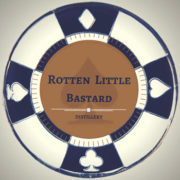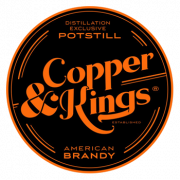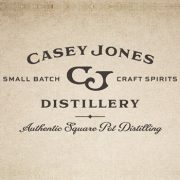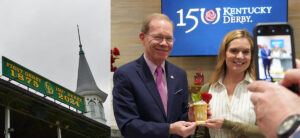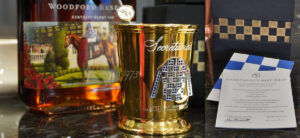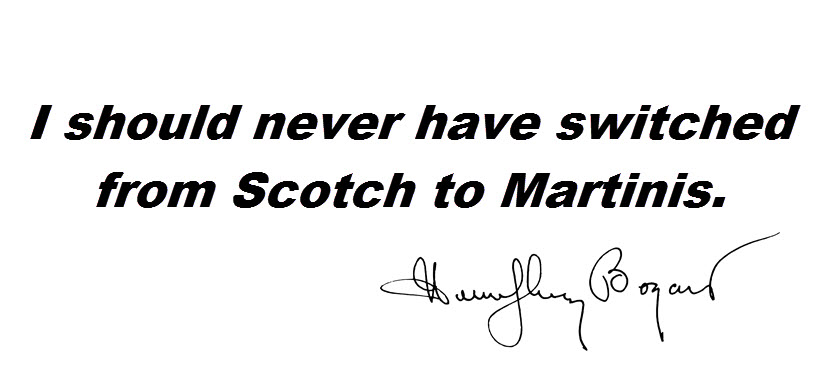
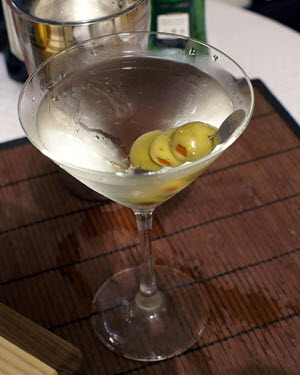
It was the love for this classic drink that spurred an entire movement, a separate martini culture, if you will, within the broader cocktail scene. Fancy, short drinks served in cocktail glasses that are often quite strong and come in almost any flavor imaginable have come to be known as ‘martinis.’ Some, like the Manhattan and Rob Roy, are as classic as their gin cousin, while much newer cocktails mix everything from vodka, apples to chocolate or coffee to hot peppers into the so-called ‘Tinis. What better way to celebrate National Martini Day than to imbibe in a few a these classics.
I should never have switched from scotch to martinis.
~ Famous last words of Humphrey Bogart
Although the exact origin of the Martini is unknown, this iconic drink has earned a permanent place in the pantheon of classic cocktails. The first printed recipe for a “Martinez” cocktail appeared in a bartending manual published in San Francisco in 1887. However, historians disagree over whether the beverage actually originated on the West Coast. In 1911, a New York City bartender named Martini di Arma di Taggia began serving a cocktail made with gin, vermouth, orange bitters, and an olive garnish. The martini gained widespread popularity among Manhattan socialites, and has been associated with New York ever since.
The biggest battle involving taking credit for the martini is in California where the cities of San Francisco and the ‘Martinez’ cocktail are squabbling about bragging rights. The martini can be found in the 1887 manual of bartender Jerry Thomas from San Francisco and people believe that he may have invented the drink as early as the 1860s. One of the most well-known theories is that the drink originated during the mid-1800s Gold Rush, in Martinez, California, just north of the Bay. While celebrating his recent rise to wealth, a gold miner ordered champagne at a local bar. However, the bar didn’t have any champagne, so the bartender suggested that he try another cocktail from the ingredients he had: vermouth, gin, maraschino liqueur, bitters and a lemon slice, calling it ‘The Martinez Special.’ Soon after, he ordered another in San Francisco (having to instruct the bartender on how to properly prepare it). By 1880, the drink had gained such popularity that it was published in the Bartenders Manual.
Here is another from Barnaby Conrad III’s book titled ‘The Martini: An Illustrated History of an American Classic’, where he explains that the drink was actually invented in the city of San Francisco when a miner, who was on his way to the city of Martinez, asked for a drink. The more logical story to me is that the drink is believed to either have gotten its name from Martinez or, as more commonly believed, from an Italian vermouth maker, Martini & Rossi, who also made a dry vermouth called Martini & Rossi, which dates back to approximately 1863 . Over a hundred years later, the Martini remains an American favorite and is definitely not one to miss when you visit its birthplace.
Today, over 50% of all cocktails are served in a martini/cocktail glass. Anything served in a martini glass that is not a classic martini must be aptly referred to as a cocktail glass. Some of the most famous (historical and fictional) martini lovers include: John D. Rockefeller, Humphrey Bogart, Franklin D. Roosevelt, Clark Gable, Ernest Hemingway, and James Bond (unbeknownst to most people, he prefers to drink Scotch on the rocks).
Martinis are one of the most important classic cocktails, so it is only natural that someone out there decided it should have its own nationally recognized day. The Martini is such a big part of our culture now that we began to wonder where it actually came from. Who is responsible for making this cocktail happen?
You are probably familiar with the many current variations of the martini, like the always popular Apple-tini or Espresso ‘Martini’, but the basic martini just started out as gin and vermouth. Unfortunately, that’s just about the only thing in the martini’s history that we are pretty sure of. When it comes down to who actually invented the drink…well, that’s a little sketchier.
The Martinez
This classic recipe first appeared in O.H. Byron’s 1884 Modern Bartenders’ Guide.
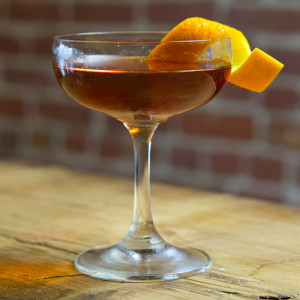
Photo courtesy of Liquor.com
Ingredients
- 1 1/2 oz Old Tom Gin
- 1 1/2 oz Sweet vermouth
- 1/4 oz Luxardo Maraschino Liqueur
- 2 dashes Angostura Bitters
- Garnish: Orange twist
Glass: Coupe
Instructions
- Add all ingredients to a shaker and fill with ice.
- Shake and strain into a chilled coupe glass.
Classic Dry Martini
(Cover photo). The Dry Martini is a classic cocktail that has lost its place in history. Although the original of the libation is obscure (so many theories), the Dry Martini has maintained a place in cocktail history as an elegant and sophisticated elixir for cocktailians and those yearning for the stiffest drink on the earth.
Ingredients
- 2 1/2 oz Beefeater Gin
- 1/2 oz Dry vermouth
- 1 dash Orange bitters (optional)
- Garnish: Lemon twist or 3 olives
Glass: Cocktail
Instructions
- Add all the ingredients to a mixing glass and fill with half ice.
- Stir with a bar spoon until well chilled for about 20 rotations each direction and strain into a chilled cocktail glass using a julep strainer.
- Garnish with a lemon twist (rub around the rim 12 o’clock to 6 on both sides, twist over and drop in) or 3 olives on a skewer (3 for the Holy Trinity and for Good Luck!). If you are going to use stuffed olives, don’t let them swim in the drink. They change the taste and make the martini cloudy, just eat them.
- Pour used ice into a rocks glass and place next to martini.
- Use ice to dilute the martini or keep it nicely chilled.
Variations
Stir all unless otherwise noted and always use a side of used ice in a rocks glass with these martinis. Although not classic, all classic-type martinis can be on rocks (use same measurements).
50/50 Martini – equal parts dry vermouth to gin. Stir
In & Out Martini – swirl the vermouth in the martini glass to flavor it and then dumps out the vermouth. Proceed with just gin. Stir
Very Dry Martini – splash of vermouth (1/4 oz) or no vermouth. Stir
Dirty Martini – this concoction has become one of the most popular modern cocktails. Adding a bit of olive brine (1/2 oz or more depending on how dirty you want it) to the classic recipe above. This gives the drink a whole new flavor. And while any kind of brine will work, try using the juice from unpitted green olives. Bottle it ahead of time – don’t pour from olive jar. Lightly shake to combine olive brine with other ingredients, but don’t make too cloudy.
1942 Martini – use tequila in place of gin. Use 1 1/2 oz reposado or anejo tequila, 3/4 oz dry vermouth, and a dash of orange bitters. Shake, not stir, and add orange peel or twist.
Gibson – classic martini with 3 cocktail onions as garnish. Stir
Gimlet – use 1/2 oz lime juice in place of dry vermouth. Stir
Perfect Martini – equal parts dry vermouth and sweet vermouth (1/2 oz, 2 oz of gin or vodka). Stir
Emerson
This cocktail is very similar to the classic Aviation and is included here because it is classic in nature with gin and sweet vermouth.
Ingredients
- 2 oz Bluecoat Gin
- 1 oz Sweet vermouth
- 1/2 oz lemon juice
- 1/2 oz Maraschino liqueur
- Garnish – Lemon twist
Glass – Cocktail
Instructions
- Pour ingredients into a shaker with ice.
- Shake well and strain into a chilled cocktail glass.
- Garnish lemon twist by rubbing around the rim 12 o’clock to 6 on both sides, twist over the drink to release oils and drop in.
Bronx
Another martini-type cocktail with classic ingredients but with juice.
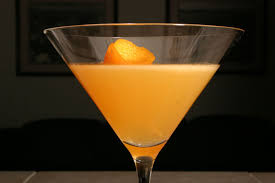
Photo courtesy of Smithsonian Magazine
Ingredients
- 1 1/2 oz Brooklyn Gin
- 1/4 oz Dry vermouth
- 1/4 oz Sweet vermouth
- 1 oz pulp-free orange juice
- Garnish – Orange twist
Glass – Cocktail
Instructions
- Pour the ingredients into a shaker with ice.
- Shake well and strain into a chilled cocktail glass.
- Garnish with the orange twist.
Vesper
Pay tribute to 007 by mixing up his signature cocktail. The drink first appeared in Ian Fleming’s 1953 novel Casino Royale when Bond asked for “Three measures of Gordon’s, one of vodka, half a measure of Kina Lillet. Shake it very well until it’s ice-cold, then add a large thin slice of lemon peel. Got it? -Casino Royale, Chapter 7. Kina Lillet Bond is a brand of dry vermouth made in France since the late 1800’s that is often referred to as the apèritif of Bordeaux. Bond’s glassware of choice for the Vesper is a deep Champagne goblet.This is very, very potent. Drink with caution!
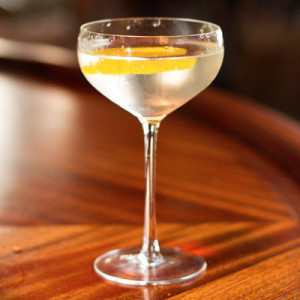
Photo courtesy of Liquor.com
Ingredients
- 3 oz Plymouth gin or other classic gin, like Gordon’s
- 1 oz Belvedere vodka
- 1/2 oz Kina Lillet Blanc or other Lillet Blanc
- Garnish: Lemon peel
Glass: Cocktail
Instructions
- Add all the ingredients to a mixing glass and fill with half ice.
- Stir and strain into a chilled cocktail glass.
- Twist a slice of lemon peel over the drink, rub along the rim of the glass and drop in.
Have a great Father’s Day everybody and hope you enjoy this Martini primer. Happy mixing and Cheers!
Stay Informed: Sign up here for our Distillery Trail free email newsletter and be the first to get all the latest news, trends, job listings and events in your inbox.


